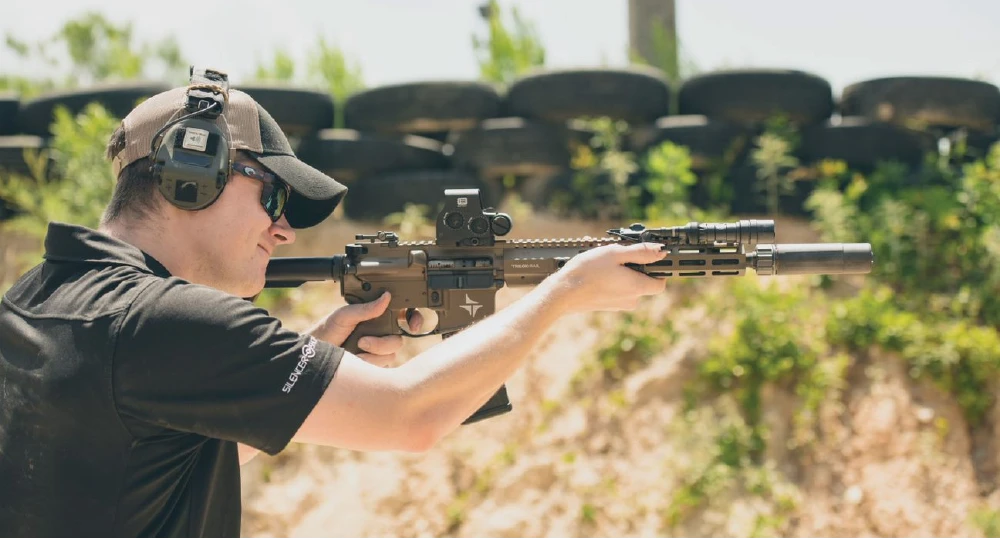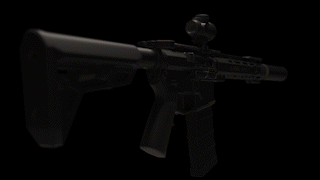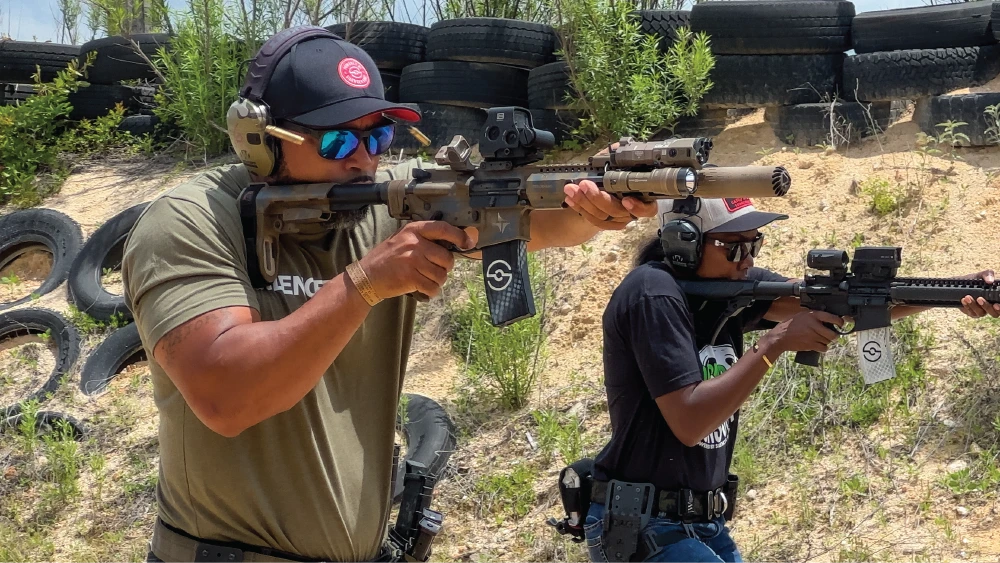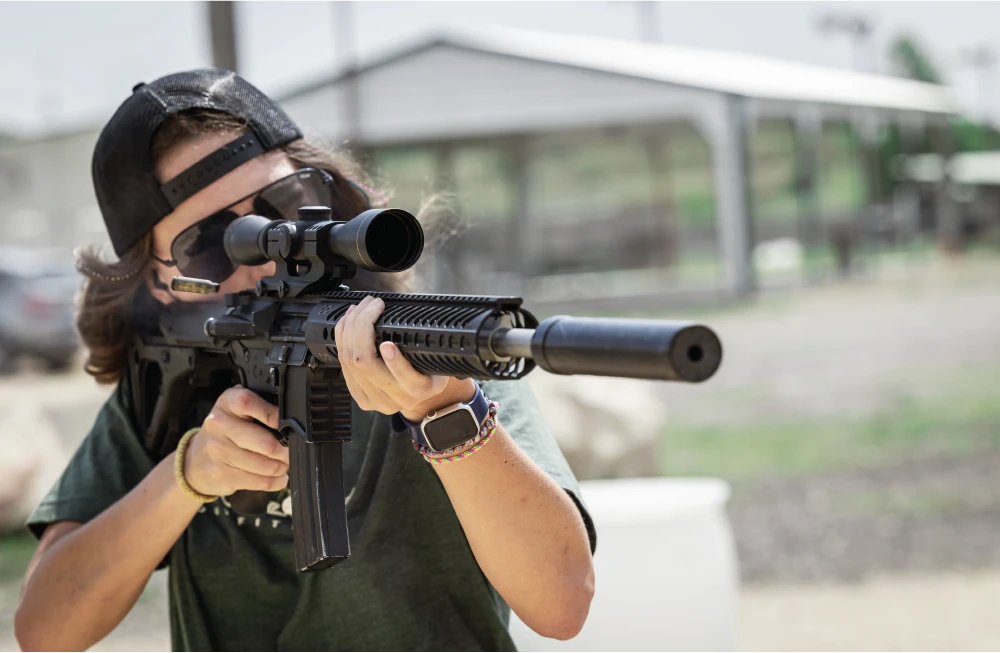Customize AR 15 For Silencers
The beauty of the AR platform is that you can make it your own, you can adapt the rifle to fill any role you desire of it, from long-barreled builds for precision target shooting and hunting to short barreled rifles for tactical training and home defense. This same level of customization makes AR15s excellent suppressor hosts. Because every single part of the rifle can be swapped with basic tools and a little know-how, you can easily set these rifles up for optimal suppression. That means less noise, less recoil, less gas in your face, and less parts wear; the benefits are nearly endless. Whether you're going to build a custom AR 15 suppressor host or upgrade one that you already have, choosing the right parts will make your rifle an ideal suppressed AR.
The AR15 was developed by Armalite in the 1950s, the primary focus of the rifle was building a platform that was reliable in adverse conditions and was easy to operate. The AR platform quickly became more and more modular, allowing shooters to swap out different parts to fit their rifles to their needs. The ease of customization is what has led to the proliferation of the AR15 across America.
Table of Contents
Why Build a Custom AR?
Building your own AR 15 allows you to pick the ideal parts to maximize your weapon system's performance and get the most out of your rifle when shooting suppressed. You can easily assemble an AR 15 at your home with just a few simple tools and following basic instructions, some people refer to AR 15 kits as "adult Legos" because of how easy they are to put together. If you're curious about how to build an AR15, we've written a step-by-step AR 15 build guide to walk you through the process. This level of customization has led AR enthusiasts to find combinations of parts that result in ultra-flat shooting, supremely quiet rifles without getting any gas in their eyes.
If you want to see just how effective a custom built AR can be, check out our Suppressor Ready Firearms build video. In that video, we cover how to build an AR specifically for suppressors and put our optimized AR15 to the test to see how good a purpose-built rifle can get.


Tuning an AR 15
Silencers enhance the functionality of the AR15 platform. You can take a silencer out of the box, attach it to your stock rifle, and as soon as you pull the trigger, you'll notice your ears aren't ringing, and the muzzle barely moved. For most people, the benefits gained from attaching a suppressor would be more than enough; their ears would be safe, they'd have a smile on their face, and their rifles would run great. But there is a group of us who want to push the boundaries of the level of performance we can extract from a weapon system to create the best suppressor host rifles possible; that is where tuning comes into play.
The AR system is driven by combustion gas. The goal of tuning your rifle is to let just enough gas through the gas port to reliably cycle the weapon 100% of the time but to have minimal excess gas. Excess gas leads to a snappier shooting rifle, more gas in your eyes, and more port noise (one of the loudest parts of the gunshot). By using an adjustable gas block, a heavier buffer system, and a gas-defeating charging handle, we can optimize the suppressed AR15 to be perfectly reliable while being as quiet and soft shooting as possible, all without any gas in your face. Tuning can be especially helpful for left-handed shooters whose face is closer to the ejection port, causing them to be affected by gas and port noise even more.




Adjustable Gas Blocks:
The first step in creating a perfectly tuned rifle is to limit the amount of gas coming back to the Bolt Carrier Group (BCG). Most gas ports on AR15 barrels are oversized to allow for reliable cycling, an adjustable gas block, like the JP AGB, enables you to change the size of the gas port to reduce the gas coming back into the action. After getting rid of the bulk of the excess gas, you'll immediately have a better shooting experience. Your rifle will shoot smoother, port noise will be vastly reduced, and you won't be tearing up from gas in your eyes.
Heavy Buffers:
Keeping the bolt locked in battery longer decreases the pressure inside the barrel; this leads to less port pop and less residual gas coming from the barrel. To keep the bolt locked we use a heavier buffer, this creates extra resistance for the BCG to overcome, extending the time that the bolt is engaged with the barrel. Systems like the JP Silent Capture Spring allow you to tune the resistance by using different springs, and this system has the added advantage of removing any spring noise thanks to the guide rod. You could accomplish a similar goal by using a weighted buffer (such as an H2 weight) in a traditional buffer system.
Gas-Defeating Charging Handles:
Gas-busting charging handles, like the Radian Raptor SD, are a great upgrade to your AR15. The Raptor SD has vents cut into the body of the charging handle to disperse any gas that made its way back into the upper receiver and features a raised ledge to better seal against the upper receiver, eliminating any gas getting into your eyes. This charging handle is also incredibly robust and has ambidextrous levers, which makes racking the gun much easier.
Low Backpressure Silencers:
New technologies in the silencer industry have allowed for baffle designs that create less backpressure, remedying the inconveniences of over-gassing. These silencers make great AR 15 suppressors due to their high-flow designs. Suppressors like the HUXWRX Flow 762 Ti and Sig Sauer SLX556-QD are designed to push excess gas down range instead of into your face while also protecting your ears.


Do Suppressors Increase Velocity
Suppressors often increase velocity between 10-30 feet per second (FPS) for supersonic cartridges such as .223 Remington. This velocity increase slightly improves ballistic performance and leads to a flatter bullet trajectory. You may not notice a big difference in ballistics if you're hunting deer or plinking at 150 yards, but if you're trying to push your rifle to the limit of its long-range capability, any added velocity is a big benefit.
Do Suppressors Affect Accuracy
Attaching an AR15 suppressor will usually increase the accuracy of your rifle. Silencers will shrink your group size and make taking follow-up shots easier thanks to the reduced recoil and muzzle rise from shooting suppressed. Accuracy can be described in two different ways, and silencers affect these distinctions differently.
Precision describes your rifle's ability to send a bullet to the exact point that your crosshairs are aiming at, IE, you hit where you were aiming. This is also called equal Point of Aim and Point of Impact, or Zero. Attaching a silencer, or any muzzle device, will usually change the point of impact of your weapon, meaning you will have to re-zero your firearm with the silencer to regain optimal precision.
Dispersion refers to the repeatability of your rifle, IE, your group size. A suppressor will help shrink your group sizes and help you to shoot more consistently. If you and your rifle normally shoot a 2-inch group at 100 yards (2MOA) you might see closer to a 1-inch group (1MOA) after attaching the silencer.
If you want to be a more accurate and precise shooter (and who doesn't?), shooting suppressed is a great way to improve your shooting skills and your rifle's performance.


Conclusion
The AR15 is America's rifle for good reason, these guns can be adapted to fit you and your shooting style perfectly. The AR is especially beloved by suppressor enthusiasts for its ability to be easily optimized for suppressor usage; swapping out a few simple parts can net great gains in the performance of the rifle and the silencer. Tuning your rifle to pair with your specific silencer will boost your shooting experience to the maximum, you'll be grinning after every trigger pull.





